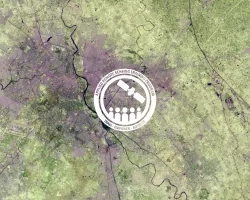Description
September 14, 16, & 21, 2021: 11:00-12:30 EDT (UTC-4)
Estuaries are water bodies where freshwater from rivers and streams meets with seawater. Coastal and estuarine waters are important to humans as they are highly productive habitats supporting a variety of fish and wildlife. These environments also provide resources, economic benefits, and ecosystem services. That being said, the water quality of these coastal and estuarine areas is of great importance. This is heavily influenced by the flow of nutrients and sediment from land-based sources. The flow of nitrogen and phosphorus in particular enhances algal bloom and hypoxia in the water, highly affecting benthic creatures like fish, shellfish, and crustaceans. Water quality in estuaries also depends on several factors such as their size, location, coastal land use, quality of freshwater runoff, and tidal effects from the sea.
Remote sensing observations from Aqua/MODIS have enabled us to monitor coastal and estuarine water quality since mid-2000. As MODIS nears the end of its mission, it is important to transition to VIIRS (first launched in 2011) to provide continuity with the MODIS instrument and add to the moderate-resolution, long-term data record of water quality monitoring in estuaries. This intermediate-level webinar will provide an overview of recent satellites and sensors used for extending the MODIS long-term water quality time series, specifically focusing on VIIRS image processing using the NASA Ocean Color software, SeaDAS. This webinar will point out similarities and differences between MODIS and VIIRS and demonstrate water quality monitoring procedures using these sensors in selected coastal and estuarine regions.
- Fundamentals of Remote Sensing (Session 1: Fundamentals of Remote Sensing and Session 2C: Fundamentals of Aquatic Remote Sensing)
- Processing Satellite Imagery for Monitoring Water Quality
By the end of this training, attendees will be able to:
- Identify recent satellite data useful for water quality monitoring
- Process MODIS and VIIRS images using SeaDAS to get water quality parameters
- Monitor water quality in selected coastal and estuarine regions
Federal, state, regional, and local public and private organizations involved in water quality and estuarine ecosystem management.
- Three 1.5-hour parts
- Two sessions on each day of the training with one being conducted in English (11:00-12:30 EDT) and the other in Spanish (16:00-17:30 EDT)
- Those who attend all three live sessions and complete the homework will be awarded a certificate of attendance.
- Background information about estuaries and their water quality
- Introduction to recent satellites and sensors relevant for monitoring water quality
- Comparison of MODIS and VIIRS for water quality monitoring
- Demonstration of VIIRS data acquisition
Optional: Although NOT A PREREQUISITE, in this series there will be a demonstration of SeaDAS/Ocean Color Science Software (OCSSW) for MODIS and VIIRS Image Processing in the Chesapeake Bay. If you wish to follow along with this demonstration, please: Install SeaDAS: https://seadas.gsfc.nasa.gov/
Materials:
- Overview of Image Processing
- Demonstration of using SeaDAS/Ocean Color Science Software (OCSSW) for MODIS and VIIRS Image Processing in the Chesapeake Bay
- Overview of the NOAA Coast Watch Water Quality Product for Puerto Rico using VIIRS
Materials:
Case Study Areas: 1) the Chesapeake Bay and 2) Río de la Plata
- Importance and ecosystems of the study areas
- Demonstration of water quality monitoring, including sea surface temperatures, chlorophyll-a concentration, and particulate organic carbon in the two estuaries
Materials:



